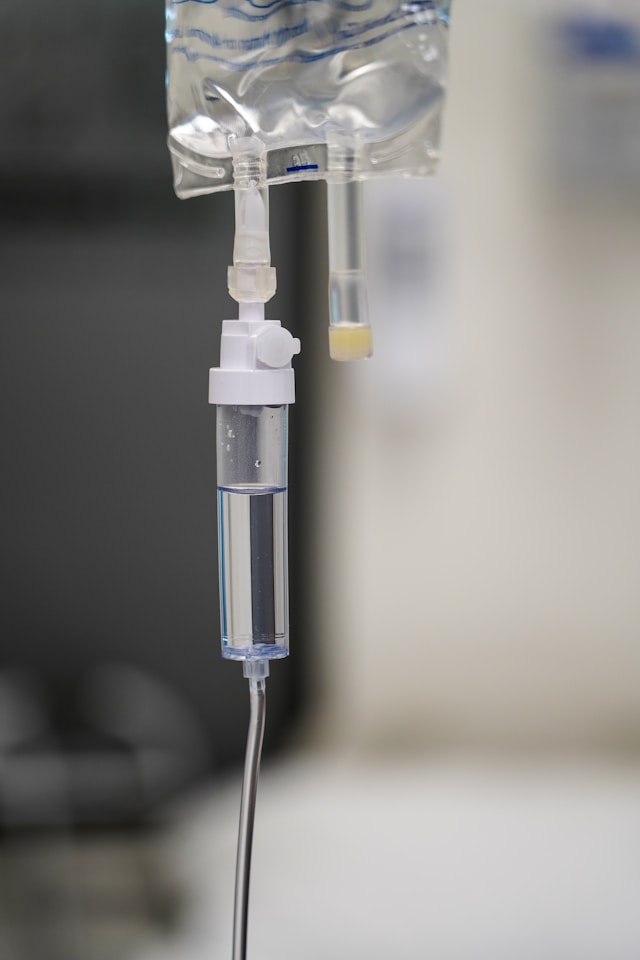
Iron Infusions: What to Expect


Dr. Chen is a board-certified immunologist with over 15 years of experience treating autoimmune and immunodeficiency disorders. She specializes in IVIG therapy and has published extensively on immune system treatments.
Medical Disclaimer
Iron deficiency anemia is one of the most common nutritional deficiencies worldwide, causing fatigue, weakness, and numerous other symptoms that significantly impact quality of life. When oral iron supplements don't work—whether due to intolerance, poor absorption, or severe deficiency—iron infusions offer a fast, effective solution. Understanding what iron infusions are and what to expect helps you approach this treatment confidently.
Key Highlights
- Iron infusions rapidly replenish iron stores by delivering iron directly into the bloodstream, bypassing digestive system absorption issues.
- Most iron infusion protocols involve 1-2 infusions over 1-2 weeks, with patients typically noticing energy improvement within days to weeks.
- Common formulations include Injectafer, Venofer, Feraheme, and Monoferric, with infusion times ranging from 15 minutes to 2-3 hours depending on the product.
Understanding Iron Deficiency Anemia
Iron is essential for producing hemoglobin, the protein in red blood cells that carries oxygen throughout your body. When iron stores become depleted, your body cannot produce enough healthy red blood cells, leading to anemia.
Common causes of iron deficiency include inadequate dietary intake, chronic blood loss (heavy menstrual periods, gastrointestinal bleeding), poor absorption (celiac disease, inflammatory bowel disease, gastric bypass), increased needs (pregnancy, rapid growth), and chronic kidney disease.
Symptoms of iron deficiency anemia include fatigue and weakness, pale skin, shortness of breath, dizziness, cold hands and feet, brittle nails, unusual cravings for non-food items (pica), rapid heartbeat, headaches, and restless leg syndrome. According to the American Society of Hematology, iron deficiency anemia affects millions of Americans, significantly impacting energy levels and quality of life.
When Iron Infusions Are Needed
Iron infusions become necessary when oral iron supplementation is inadequate:
Intolerance to Oral Iron: Many patients experience significant gastrointestinal side effects (nausea, constipation, stomach pain, dark stools) from oral iron that make daily supplementation impossible.
Malabsorption: Conditions like inflammatory bowel disease, celiac disease, or gastric bypass surgery impair iron absorption from the digestive tract, making oral supplements ineffective.
Severe Deficiency: When iron levels are critically low, oral supplementation takes too long to replenish stores. Infusions work much faster.
Ongoing Blood Loss: Patients with chronic bleeding (heavy periods, GI bleeding) may not absorb oral iron quickly enough to keep pace with losses.
Chronic Kidney Disease: CKD patients, particularly those on dialysis, commonly develop iron deficiency and require IV iron replacement.
Inflammatory Conditions: Chronic inflammation can interfere with oral iron absorption and utilization, making infusions more effective.
Pre-Surgical Preparation: Patients with anemia scheduled for surgery may receive iron infusions to optimize red blood cell levels before the procedure.
Types of Iron Infusions
Several iron formulations are available for IV administration:
Injectafer (Ferric Carboxymaltose): One of the most commonly used formulations. Given as two 750 mg infusions (for patients weighing ≥50 kg) over 15-30 minutes each, spaced one week apart. Total dose: 1,500 mg. Very convenient with quick infusion times.
Venofer (Iron Sucrose): Requires multiple infusions of 200 mg each over 2-3 hours, typically 5-10 infusions depending on iron deficit. Total treatment takes several weeks. Longer course but very well-tolerated.
Feraheme (Ferumoxytol): Given as two 510 mg infusions over 15 minutes each, spaced 3-8 days apart. Quick infusions and rapid iron replacement.
Monoferric (Ferric Derisomaltose): Single-dose high-dose iron (up to 1,000 mg) infused over 20 minutes. Entire treatment completed in one visit.
INFeD/Dexferrum (Iron Dextran): Older formulation less commonly used now due to higher allergic reaction risk. Requires test dose before full infusion.
According to the Mayo Clinic, newer iron formulations like Injectafer, Feraheme, and Monoferric offer improved safety and convenience compared to older products.
What to Expect During Iron Infusions
Pre-Treatment Testing: Your doctor will check hemoglobin, ferritin (iron stores), iron saturation, and complete blood count to confirm iron deficiency and determine how much iron you need.
Pre-Medications: Some centers provide antihistamines or acetaminophen before iron infusions to reduce reaction risk, though many patients receive iron without pre-medications.
IV Placement: A nurse places an IV catheter in your arm or hand.
The Infusion: Depending on the formulation:
- Injectafer: 15-30 minutes
- Feraheme: 15 minutes
- Monoferric: 20 minutes
- Venofer: 2-3 hours
During Infusion: You'll be monitored periodically. Most patients read, use devices, or rest during treatment.
Post-Infusion Monitoring: You'll remain for 15-30 minutes after infusion to ensure no delayed reactions occur.
Multiple Sessions: Most iron deficiency treatment requires 1-2 infusions (Injectafer, Feraheme, Monoferric) or multiple infusions over several weeks (Venofer).
Timeline for Improvement
Quick Response: Many patients notice energy improvement within 3-7 days of iron infusion, though some take 1-2 weeks to feel significantly better.
Hemoglobin Rise: Red blood cell counts typically begin rising within 1-2 weeks and continue improving for 4-8 weeks.
Ferritin Replenishment: Iron stores (measured by ferritin) replenish within weeks and remain elevated for months.
Maximum Benefit: Full energy restoration and symptom resolution typically occurs within 4-8 weeks of completing iron replacement.
Duration of Effect: Replenished iron stores may last 6-12 months or longer if the underlying cause of deficiency is addressed. Some patients need periodic iron infusion "top-ups" if the cause of deficiency persists.
Benefits of Iron Infusions
Rapid Iron Replenishment: Much faster than oral supplementation, which takes months to rebuild stores.
Bypasses Absorption Issues: Delivers iron directly into bloodstream regardless of digestive function.
No GI Side Effects: Eliminates constipation, nausea, and stomach upset common with oral iron.
Improved Energy: Most patients experience dramatic energy improvement and resolution of fatigue.
Better Exercise Tolerance: Increased oxygen-carrying capacity improves endurance and reduces breathlessness.
Symptom Resolution: Elimination of dizziness, weakness, cold sensitivity, restless legs, and other anemia symptoms.
Fewer Infusions Needed: Modern high-dose formulations complete treatment in 1-2 sessions rather than months of daily pills.
Improved Quality of Life: Restoration of normal energy levels transforms daily function and wellbeing.
Potential Side Effects
Metallic Taste: Brief metallic taste during infusion is common and harmless.
Nausea: Mild nausea can occur during or after infusion, usually temporary.
Headache: Some patients experience headaches, typically mild and responsive to over-the-counter pain relievers.
Muscle or Joint Aches: Temporary body aches can occur, usually resolving within 24-48 hours.
Injection Site Reactions: Mild pain, redness, or discoloration at IV site is possible.
Hypersensitivity Reactions: Rare allergic reactions can include rash, itching, chest tightness, shortness of breath, or blood pressure changes. Infusion centers are prepared to manage these. Risk varies by formulation—newer products have lower allergic reaction rates than older iron dextran.
Hypophosphatemia: Some iron formulations (particularly Injectafer) can temporarily lower blood phosphate levels. Usually asymptomatic but monitored.
Staining: Iron can cause temporary skin staining if it leaks outside the vein during infusion (extravasation). Proper IV placement prevents this.
Dark Stools: After iron infusions, stools may appear darker for several days—this is normal and not concerning.
Most patients tolerate iron infusions very well with minimal or no side effects.
After Your Iron Infusion
Activity: You can resume normal activities immediately after infusion. Some patients feel tired and prefer to rest; others feel energized.
Follow-Up Testing: Your doctor will typically recheck blood counts and iron studies 4-8 weeks after completing iron replacement to assess response.
Identifying the Cause: Important to determine why iron deficiency developed. Your doctor may recommend colonoscopy, endoscopy, or evaluation for heavy menstrual bleeding to find and address the source.
Maintenance: If the underlying cause of iron deficiency persists and cannot be corrected, you may need periodic iron infusions (every 6-12 months or as needed based on monitoring) to maintain adequate iron stores.
Oral Iron After Infusion: Some patients resume low-dose oral iron supplementation after infusions to maintain stores if they can tolerate it.
Cost and Insurance Considerations
Iron infusions typically cost $400-$4,000 per treatment course depending on formulation:
Insurance Coverage: Most insurance plans cover iron infusions when documented oral iron intolerance or malabsorption exists, or when iron deficiency is severe.
Prior Authorization: Many plans require trying oral iron first unless contraindications exist.
Medicare Coverage: Medicare Part B covers iron infusions for beneficiaries meeting medical necessity criteria.
Out-of-Pocket Costs: Copays and coinsurance vary widely by plan. Some patients find hospital outpatient departments more expensive than freestanding infusion centers.
Frequently Asked Questions
How long does iron infusion take?
Iron infusion duration depends on the formulation. Injectafer, Feraheme, and Monoferric infuse in 15-30 minutes, making them very convenient. Venofer takes 2-3 hours per infusion. Total appointment time including check-in, IV placement, the infusion, and post-monitoring is typically 1-2 hours for quick formulations or 3-4 hours for Venofer.
How quickly will I feel better after iron infusion?
Most patients notice energy improvement within 3-7 days, though some take 1-2 weeks. Full symptom resolution and maximum energy restoration typically occurs within 4-8 weeks as your body produces new red blood cells using the replenished iron. Some people feel dramatically better within days, while others improve more gradually. If you don't feel significantly better after 4-6 weeks, follow up with your doctor.
How many iron infusions will I need?
This depends on your iron deficit and which formulation is used. Injectafer typically requires 2 infusions one week apart. Feraheme requires 2 infusions 3-8 days apart. Monoferric may be given as a single infusion. Venofer requires 5-10 infusions over several weeks. Your doctor calculates the total iron dose needed based on your weight, hemoglobin, and iron levels, then determines the appropriate number of infusions.
Are iron infusions safe?
Yes, iron infusions are generally very safe when administered by trained healthcare providers. Serious allergic reactions are rare, particularly with newer iron formulations. Common side effects like metallic taste, mild nausea, or headaches are usually minor and temporary. The risk of serious reactions is much lower with modern iron products (Injectafer, Feraheme, Monoferric, Venofer) compared to older iron dextran formulations.
Will I need iron infusions again?
This depends on the underlying cause of your iron deficiency. If the cause is identified and corrected (treating GI bleeding, managing heavy periods, improving diet), you may not need additional infusions. If the underlying problem persists or cannot be fully resolved, you may need periodic iron infusion "top-ups" every 6-12 months or as determined by blood test monitoring. Many patients need just one treatment course, while others require ongoing intermittent iron replacement.
Rapidly Restoring Your Energy
For patients with iron deficiency anemia who cannot tolerate or absorb oral iron, IV iron infusions offer rapid, effective treatment that can dramatically improve energy levels and quality of life within days to weeks. The convenience of 1-2 brief infusions completing treatment makes iron replacement manageable even for busy schedules.
Most patients are amazed at how much better they feel once iron stores are replenished—the fatigue, weakness, and other symptoms that gradually developed often resolve quickly, allowing return to normal energy and function.
Ready to find an infusion center for iron replacement therapy? Explore infusion providers near you offering iron infusions for anemia treatment.
Medical Disclaimer: This content is for educational purposes only and is not a substitute for professional medical advice, diagnosis, or treatment. Always consult your healthcare provider with questions about your medical condition or treatment options.
Article Statistics


Table of Contents
Article Statistics










